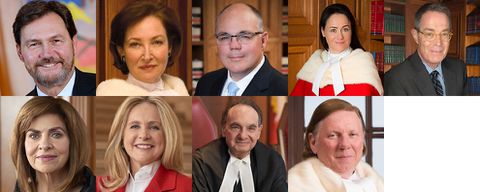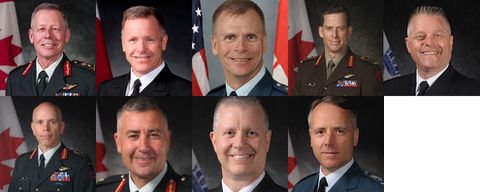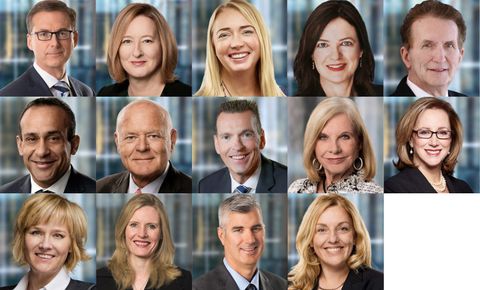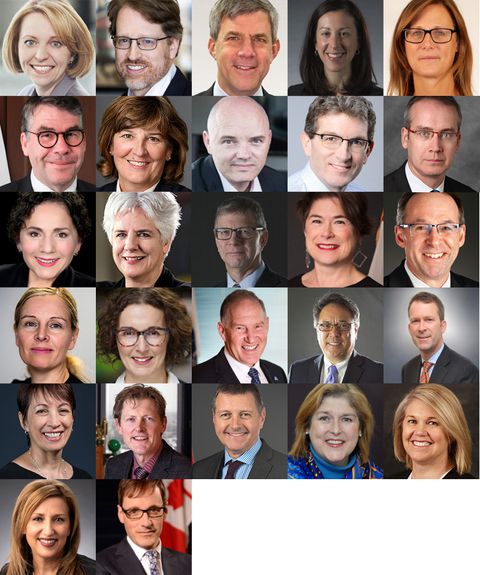Trudeau says he wants to tackle systemic racism. He should start with reforming bilingualism.
Amid the litany of promises in his government’s throne speech last week, Canadian Prime Minister Justin Trudeau vowed to pursue two deeply contradictory goals with little introspection.
On the one hand, his administration says it will tackle “systemic racism” and break down the “systemic barriers” that exclude people of color from full participation in Canadian life. On the other hand — immediately after, in fact — the speech also vowed to legally consolidate the status of Canada’s “two official languages,” French and English, emphasizing the need to “protect and promote French,” in particular.
The degree to which these objectives are at odds should be evident from a quick perusal of the people running Canada these days.
Here’s the Supreme Court of Canada:
 Top row, from left: Richard Wagner, chief justice; Rosalie Silberman Abella; Russell Brown; Suzanne Côté; Nicholas Kasirer; bottom row, from left: Andromache Karakatsanis; Sheilah L. Martin; Michael J. Moldaver; Malcolm Rowe. (Government of Canada)
Top row, from left: Richard Wagner, chief justice; Rosalie Silberman Abella; Russell Brown; Suzanne Côté; Nicholas Kasirer; bottom row, from left: Andromache Karakatsanis; Sheilah L. Martin; Michael J. Moldaver; Malcolm Rowe. (Government of Canada) Here are the nine officers of the federal Parliament:
 Top row, from left: Nancy Bélanger, commissioner of lobbying; Mario Dion, ethics commissioner; Joe Friday, public sector integrity commissioner; Yves Giroux, parliamentary budget officer; Karen Hogan, auditor general; bottom row, from left: Caroline Maynard, information commissioner of Canada; Stéphane Perrault, chief electoral officer; Raymond Théberge, commissioner of official languages; Daniel Therrien, privacy commissioner of Canada (Government of Canada)
Top row, from left: Nancy Bélanger, commissioner of lobbying; Mario Dion, ethics commissioner; Joe Friday, public sector integrity commissioner; Yves Giroux, parliamentary budget officer; Karen Hogan, auditor general; bottom row, from left: Caroline Maynard, information commissioner of Canada; Stéphane Perrault, chief electoral officer; Raymond Théberge, commissioner of official languages; Daniel Therrien, privacy commissioner of Canada (Government of Canada) Here are the heads of the Canadian armed forces:
 Top row, from left: Gen. Jonathan Vance, chief of staff; Rear Adm. Scott Bishop, commander of Intelligence Command and chief of defense intelligence; Lt. Gen. Christopher Coates, commander of Joint Operations Command; Maj. Gen. Peter Dawe, commander of Special Operations Forces; Vice Adm. Haydn Edmundson, commander of Military Personnel Command; bottom row, from left: Lt. Gen. Wayne D. Eyre, commander of the Canadian Army; Maj. Gen. Omer Lavoie, director of Strategic Joint Staff; Vice Adm. Art McDonald, commander of the Royal Canadian Navy; Lt. Gen. A.D. Meinzinger, commander of the Royal Canadian Air Force (Government of Canada)
Top row, from left: Gen. Jonathan Vance, chief of staff; Rear Adm. Scott Bishop, commander of Intelligence Command and chief of defense intelligence; Lt. Gen. Christopher Coates, commander of Joint Operations Command; Maj. Gen. Peter Dawe, commander of Special Operations Forces; Vice Adm. Haydn Edmundson, commander of Military Personnel Command; bottom row, from left: Lt. Gen. Wayne D. Eyre, commander of the Canadian Army; Maj. Gen. Omer Lavoie, director of Strategic Joint Staff; Vice Adm. Art McDonald, commander of the Royal Canadian Navy; Lt. Gen. A.D. Meinzinger, commander of the Royal Canadian Air Force (Government of Canada) Here’s the board of the Bank of Canada:
 Top row, from left: Tiff Macklem, governor of the bank; Carolyn A. Wilkins, senior deputy governor; Debora Bielecki; Stephanie Bowman; Robert Campbell; Middle row, from left: Peter P. Dhillon; Paul G. Haggis; Raymond E. Ivany; Monique Jérôme-Forget; Monique Mercier; Bottom row, from left: Mariette Mulaire; Claire M.C. Kennedy; Greg Stewart; Anne Whelan (Government of Canada)
Top row, from left: Tiff Macklem, governor of the bank; Carolyn A. Wilkins, senior deputy governor; Debora Bielecki; Stephanie Bowman; Robert Campbell; Middle row, from left: Peter P. Dhillon; Paul G. Haggis; Raymond E. Ivany; Monique Jérôme-Forget; Monique Mercier; Bottom row, from left: Mariette Mulaire; Claire M.C. Kennedy; Greg Stewart; Anne Whelan (Government of Canada) And here are the deputy ministers of the federal government’s departments — the people often considered the true leaders of the cabinet ministries — in early September:
 Top row, from left: Nathalie G. Drouin, deputy minister of justice; Graham Flack, deputy minister of employment and social development; Chris Forbes, deputy minister of agriculture and Agri-Food Canada; Christiane Fox, deputy minister of intergovernmental affairs and youth; Kelly Gillis, deputy minister of infrastructure and communities; second row, from left: John Hannaford, deputy minister of international trade; Christine Hogan, deputy minister of environment and climate change; Dylan Jones, deputy minister of Western Economic Diversification Canada; Michael Keenan, deputy minister of Transport Canada; Simon Kennedy, deputy minister of Innovation, Science and Economic Development Canada; third row, from left: Yazmine Laroche, deputy minister of public service accessibility; Hélène Laurendeau, deputy minister of Canadian Heritage; Stephen Lucas, deputy minister of health; Leslie MacLean, deputy minister of international development; Bill Matthews, deputy minister of public services and procurement; fourth row, from left: Isabelle Mondou, deputy minister responsible for Covid-19 response (communications); Marta Morgan, deputy minister of foreign affairs; Walt Natynczyk, deputy minister of veterans affairs; Daniel Quan-Watson, deputy minister for crown-Indigenous relations and Northern affairs; Paul Rochon, deputy minister of finance; fifth row, from left: Guylaine F. Roy, deputy minister of tourism, official languages and La Francophonie, and deputy minister of women and gender equality; Timothy Sargent, deputy minister of Fisheries and Oceans Canada; Rob Stewart, deputy minister of Public Safety Canada; Catrina Tapley, deputy minister of Immigration, Refugees and Citizenship Canada; Jody Thomas, deputy minister of national defense; Christyne Tremblay, deputy minister of natural resources; Jean-François Tremblay, deputy minister of Indigenous services. Positions listed are from early September. (Government of Canada)
Top row, from left: Nathalie G. Drouin, deputy minister of justice; Graham Flack, deputy minister of employment and social development; Chris Forbes, deputy minister of agriculture and Agri-Food Canada; Christiane Fox, deputy minister of intergovernmental affairs and youth; Kelly Gillis, deputy minister of infrastructure and communities; second row, from left: John Hannaford, deputy minister of international trade; Christine Hogan, deputy minister of environment and climate change; Dylan Jones, deputy minister of Western Economic Diversification Canada; Michael Keenan, deputy minister of Transport Canada; Simon Kennedy, deputy minister of Innovation, Science and Economic Development Canada; third row, from left: Yazmine Laroche, deputy minister of public service accessibility; Hélène Laurendeau, deputy minister of Canadian Heritage; Stephen Lucas, deputy minister of health; Leslie MacLean, deputy minister of international development; Bill Matthews, deputy minister of public services and procurement; fourth row, from left: Isabelle Mondou, deputy minister responsible for Covid-19 response (communications); Marta Morgan, deputy minister of foreign affairs; Walt Natynczyk, deputy minister of veterans affairs; Daniel Quan-Watson, deputy minister for crown-Indigenous relations and Northern affairs; Paul Rochon, deputy minister of finance; fifth row, from left: Guylaine F. Roy, deputy minister of tourism, official languages and La Francophonie, and deputy minister of women and gender equality; Timothy Sargent, deputy minister of Fisheries and Oceans Canada; Rob Stewart, deputy minister of Public Safety Canada; Catrina Tapley, deputy minister of Immigration, Refugees and Citizenship Canada; Jody Thomas, deputy minister of national defense; Christyne Tremblay, deputy minister of natural resources; Jean-François Tremblay, deputy minister of Indigenous services. Positions listed are from early September. (Government of Canada) The Toronto Star, for its part, has documented the overwhelming whiteness of the federal Canadian judiciary, noting that “there are currently two BIPOC judges — one Indigenous and one of Kurdish heritage — in the roster of 44 judges in the Federal Court,” which, the newspaper writes, mostly hears cases involving people of color.
Hiring this one-sided is usually blamed on overt and covert prejudices that combine to form the sort of “systemic barriers” Trudeau’s throne speech alluded to. In the Canadian public sector, one such systemic barrier has always been obvious — and is indeed routinely cited by diversity advocates: mandatory French-English bilingualism.
Though statutorily, the list of mandatory bilingual positions in the Canadian federal government is fairly short, Canada’s 50-year-old Official Languages Act nevertheless declares that French and English “are the languages of work in all federal institutions,” and obliges dual fluency for any job in which bilingualism is “objectively required to perform the functions” of the position.
In practice, this clause — the Section 91 rule, in Ottawa-speak — has been ever-more liberally interpreted in order to justify ever-more bilingual hires. Ottawa’s most recently issued “Directive on Official Languages for People Management” now demands that those in most executive, managerial or deputy-head-type positions be able to perform complicated tasks in both French and English.
The Official Languages Act also mandates strict and constant auditing of a civil service that’s apparently never quite bilingual enough, giving the whole project a fussiness that can even exhaust true believers. According to the most recent annual report of the federal Official Languages Commissioner, “Since 2014, commissioners of official languages have conducted more than 500 investigations into complaints involving more than 30 federal institutions regarding the language requirements of positions under section 91 of the Act.”
The discriminatory consequences of such a regime in a country that’s vastly more diverse than it was a half-century ago are pretty straightforward.
Language skills are generally acquired based on day-to-day communicative need. Given that English predominates in most of Canada, while fewer than a quarter of Canadians come from French-speaking backgrounds, those with impeccable skills in both French and English tend to be pulled from a rather narrow cultural-geographic-ethnic milieu.
“Self-starter” bilinguals, meanwhile, are frequently ambitious Anglo Canadians given French education or exposure relatively early in life — often for explicitly careerist reasons — implying priorities and privileges not all Canadians share. Canadian immigrants, or those otherwise from families in which a language other than French or English was their dominant one, face a uniquely uphill journey.
It’s always been curious how otherwise impeccably woke Canadians can turn into rigidly ideological meritocrats whenever the obviously discriminatory aspects of official bilingualism are raised. No less a wokester than Trudeau himself once declared Canadians who aren’t multilingual simply “lazy,” and this seems to be a popular rationalization. The fact that “anyone” can, in theory, learn to speak any language is often bluntly asserted as the reason why requiring French fluency can’t possibly be discriminatory — a logic many of these same people would surely find faulty if used to defend, say, exclusively hiring Ivy League grads or imposing a literacy test on voters.
Even more distressing, however, is when those with the most to lose from this system rush to defend it. Noted political celebrity Leslyn Lewis, for instance, is a Black immigrant from Jamaica who rose from humble beginnings to achieve an impressive legal career and came close to winning the leadership of the Conservative Party. Yet she embarrassed herself during her campaign by awkwardly and unsuccessfully attempting to gain overnight fluency in French, simply because that’s what Canadian received wisdom says you have to do to be taken seriously as a federal politician.
Canada can have a government that at least attempts to resemble the elaborately diverse nation it governs, or it can have one where the most important jobs are hogged by a small White subculture because 50 years ago we decided the most important issue of inclusion was accommodating the country’s French Canadian minority without English skills — a group that is now just 12 percent of the population.
But it cannot have both.
Read more:
David Moscrop: Trudeau’s new agenda is full of old promises and unrealized hopes
J.J. McCullough: Canada’s French-English bilingualism is bad policy — and worse politics
El Jones: Black Canadians are suffocating under a racist policing system, too






